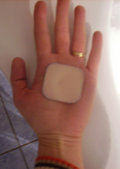The FDA has approved Ortho Evra, the first skin patch for birth control. The prescription patch works by releasing hormones through the skin into the bloodstream to prevent pregnancy.
The square patch, just under two inches wide, consists of three layers. The hormones norelgestromin and ethinyl estradiol are embedded in the adhesive layer and are slowly released when the patch is applied to the skin.
Women using the product should apply it to the lower abdomen, buttocks or upper body, but not to the breasts. The patch is worn continuously for one week and then replaced with a new patch, for a total of three weeks of patch wear. During the fourth week, no patch is used, allowing the woman to have her menstrual period.
Like birth control pills, Ortho Evra is effective for pregnancy prevention when used as directed. The risks of using this product include an increased risk of blood clots, heart attack, and stroke. The product's warning label also notes that cigarette smoking increases the risk of serious cardiovascular side effects.
The FDA approved Ortho Evra following three worldwide clinical trials involving 4,578 women, of whom 3,319 used Ortho Evra. The other women in the trials used birth control pills. The trials demonstrated that that women were able to follow the weekly patch application and changing regimen. About 5 percent of the women had at least one patch that did not stay attached to their skin. About 2 percent withdrew from the trial due to skin irritation from the patch. The product appeared to be less effective in women weighing more than 198 pounds.
Ortho Evra was developed by R. W. Johnson Pharmaceutical Research Institute and is marketed by Ortho-McNeil Pharmaceutical Inc., Raritan, N.J. The product is sold in packages of three patches for the monthly cycle of use.
COPYRIGHT 2002 U.S. Government Printing Office
COPYRIGHT 2004 Gale Group



